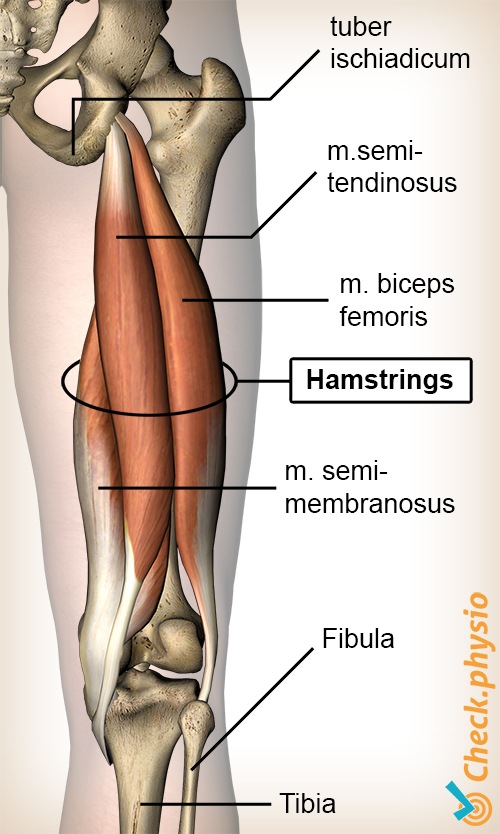- Conditions
- Acute hamstring injury
Acute hamstring injury Acute hamstring pain
Introduction
Acute hamstring injuries often occur during exercise. Everyone is familiar with the image of a footballer or athlete suddenly gripping the back of his thigh during a sprint. The sprint stops at once and the athlete drops to the ground or limps to a halt.
In this section we will describe an acute hamstring injury. If there is no obvious event that started the symptoms, this could indicate a non-acute hamstring injury.

Description of condition
When we refer to "hamstrings", we are actually referring to a group of 3 muscles. They are located at the back of the thigh and connect the sitting bone (ischial tuberosity) to the lower leg. Their main functions are flexing the knee and extending the hip. The muscles that jointly form the hamstrings are called the "semimembranosus", the "semitendinosus" and the "biceps femoris".
In an acute hamstring injury, one or more fibers of a hamstring muscle will tear. The tear usually occurs at the muscle-tendon transition. These are found at both ends of the muscle, where the rigid and sturdy tendon tissue changes to the softer muscle tissue. The muscle that is generally most often injured is the "biceps femoris".
A muscle tear is accompanied by bleeding. If a lot of fibers are torn, a blue, dark area may become visible at the back of the thigh. In severe cases where the entire muscle tears off, this is referred to as a total rupture.
Cause and history
Sprinting, getting ready to sprint or slowing down are often the moments at which symptoms can occur. Sports that involve jumping and kicking also pose an increased risk. The hamstring tear causes acute pain along the back of the thigh, after which the sporting activity generally cannot be continued.
The risk of a hamstring injury during exercise increases with increasing age. In addition, there are a number of factors that increase the risk of a hamstring injury. The most important factors are: altered muscle balance, muscle fatigue, short hamstrings, inadequate warming up and a previous hamstring injury.
Signs & symptoms
- Acute pain along the rear of the thigh, that generally starts during exercise.
- Bending the knee against resistance is painful. This pain is also felt when running and sprinting.
- Stretching the muscle is painful (touching your toes with your hands while keeping your knees straight in order to stretch the hamstrings).
- If a lot of fibers are torn, it may feel on examination as if a chunk has been taken out of the muscle.
- The tear is sensitive to the touch.
- Loss of strength.
- The affected muscle may contract and cause a cramp sensation.
- As the hamstrings attach to the sitting bones, the symptoms may also be experienced while sitting down, as this places pressure on the damaged structures.
If bleeding occurs, a blue, darker area may be visible along the rear of the thigh. This can be felt as a thickening of the leg. Over time, the bruise will move downward. This is simply due to gravity.
Diagnosis
During an interview, the healthcare professional asks about the complaints and how they occurred. Then a physical examination follows with several tests to determine the damage to the hamstrings. The acute hamstring injury is easier to diagnose than the non-acute form. With ultrasound, it is possible to quickly visualize the size of a possible tear.
Treatment and recovery
Recovery takes an average of 6 to 8 weeks. This may be slightly shorter for a mild strain. However, a total hamstring rupture - where the muscle tears or separates completely, will require surgery. In that case, recovery may take up to 3 months. Surgery within a week is strongly recommended.
Following a period of rest, the muscle must be trained very carefully. If this is not done correctly, the risk of relapse is very high. The physiotherapist can guide you throughout the process, from the onset of the injury through to resuming sports activity.
A hamstring injury is a persistent injury. Even after the injury has healed, it remains a vulnerable area. Therefore, it is important to listen closely to your own body and not to carry on running if you have symptoms.
Exercises
With an acute hamstring injury, it is important not to train too hard right away. The first phase of the injury should focus mainly on rest and light exercises. View the exercise program here with exercises for acute hamstring injury.
More info
You can check your symptoms using the online physiotherapy check or make an appointment with a physiotherapy practice in your locality.
References
Hibbert, O., Cheong, K., Grant, A., Beers, A. & Moizumi, T. (2008) A systematic review of the effectiveness of eccentric strength training in the prevention of hamstring muscle strains in otherwise healthy individuals N Am J Sports Phys Ther. 2008 May;3(2):67-81.
Heiderscheit, B.C., Sherry, M.A., Silder, A., Chumanov, E.S. & Thelen, D.G. (2010) Hamstring strain injuries: recommendations for diagnosis, rehabilitation and injury prevention J Orthop Sports Phys Ther. 2010 Feb;40(2):67-81.
Petersen, J. & Hölmich, P. (2005) Evidence based prevention of hamstring injuries in sport Br J Sports Med. 2005;39:319-323.
